Ultimate Guide to the AP Spanish Literature and Culture Exam
Of the eight languages offered through the AP World Languages and Cultures program, Spanish is the most popular choice among students. It is so popular, in fact, that there are two different Spanish language offerings. AP Spanish Language and Culture is generally the most common choice, but AP Spanish Literature and Culture is another popular option, sometimes taken after AP Spanish Language and Culture, and other times taken independently of it. In 2019, more than 216,000 AP Spanish exams were taken. AP Spanish Literature and Culture exams accounted for about 30,000 of these. If you’re interested in learning more about the AP Spanish Literature and Culture course and exam, read on. On Thursday, May 7, at 8 am, the College Board will hold the 2020 AP Spanish Literature and Culture exam. For a comprehensive listing of all the AP exam times, check out our post 2020 AP Exam Schedule: Everything You Need to Know. The AP Spanish Literature and Culture course takes a thematic approach to the introduction of representative texts (short stories, novels, poetry, and essays) from Peninsular Spanish, Latin American, and United States Hispanic literature. In this course, you will consider and critique a set of required readings (38 titles from contemporary works to those dating back to the 14th century) in the context of their time and place, reflecting on the many voices and cultures presented. While you can expect to develop proficiencies across the full range of the same modes of communication as the other AP language courses (interpersonal, presentational, and interpretive), you will hone your critical reading and analytical writing skills as well. You will also focus on cultural connections and comparisons, including the exploration of various media (e.g., art, film, articles, and literary criticism). The College Board provides these guidelines in support of its belief that the study of foreign languages and literature “provides students with access to cultural perspectives and knowledge, encourages them to make connections and comparisons between cultures and literary works, and helps them develop the ability to think critically.” There are no formal prerequisites for the AP Spanish Literature and Culture course, but make no mistake—this is not an introductory course offering. You will need to have taken the equivalent of three years of high school-level Spanish, or have significant exposure and experience with the language outside the classroom. You also might choose to take the AP Spanish Language and Culture before the AP Spanish Literature and Culture course, as all texts are presented in Spanish. The aim of the AP Spanish Literature and Culture course is to build core skills (the tools necessary to think like a literary critic and speak Spanish proficiently) and develop a deep understanding of the content taught in the course through critical reading, literary analysis, and contextualizing literary works within historical, geopolitical, sociocultural, and cultural contexts. The seven core skills, along with the weight they’re given on the multiple-choice section of the AP Spanish Literature and Culture course, are: multiple-choice section multiple-choice section multiple-choice section multiple-choice section The content of the AP Spanish Literature and Culture course is divided into six themes, each of which contains between four and six organizing concepts. Throughout the course, you will make connections between the themes and their underlying concepts. Below is a list of the six themes and their companion concepts: The core skills and content of the AP Spanish Literature and Culture course are commonly taught in eight units. Below is a suggested structure of those units by the College Board: The entire AP Spanish Literature and Culture exam is presented in Spanish, including all directions, prompts, questions, and texts. The exam lasts for three hours and contains two main sections. The first section is the multiple-choice section, which consists of 65 questions, lasts for 80 minutes, and accounts for 50% of your score. The second part of the exam is the free-response section, which contains four tasks, lasts for 100 minutes, and accounts for the remaining 50% of your exam score. The multiple-choice section of the AP Spanish Literature and Culture exam is broken down into two parts: part one using radio as a stimulus, part two using text as a stimulus. Section 1(a): Multiple-Choice Audio 20 minutes | 15 questions | 10% of score Section 1(a) of the Spanish Literature and Culture exam uses audio as a stimulus. You’ll receive three sets of questions based on three audio recordings—one expert from an interview with an author, one recited poem, and one presentation on a literary topic. Example of an audio-based multiple-choice question set (click on the question to hear the audio): Answers – 1: B | 2: A | 3: C | 4: C Section 1(b): Multiple-Choice Text 1 hour | 50 questions | 40% of score For section 1(b) of the exam, you’ll receive six sets of 7-10 questions based on readings (from both on and off the required reading list, including one passage of literary criticism about an author from the required reading list) covering a variety of genres, periods, and places. One set of questions will contain two passages that are related by theme—one passage is sourced from the required reading list, the other is from a non-required text. A sample set of text-based multiple-choice questions: Answers – 10: C | 11: B | 12: B | 13: D | 14: B | 15: B Section 2, the free-response section of the AP Spanish Literature and Culture exam, is also broken into two parts. The first part contains two short-answer questions, while the second part features two essay questions. Section 2(a): Free-Response Short Answer 30 minutes | 2 questions | 15% of score Text explanation is the subject of the first of the short-answer questions. For the text explanation question, you are provided an excerpt of text from the required reading list and tasked with identifying the author of the text and the period when it was written. You’ll also need to explain the theme of the excerpt and describe how it relates to the whole work from which it was taken. Sample of a text explanation short-answer question: Text and art comparison is the theme of the second short-answer question. For this question, you are also provided with an excerpt of text from the required reading list; however, this one is also accompanied by an image of a related piece of art—for example a painting, photo, sculpture, or drawing. You’re tasked with comparing how a particular theme is represented both in the text and the image, and will then need to connect that theme to a genre, period, or movement. Sample of a text and art comparison short-answer question: Section 2(b): Free-Response Essay 1 hour 10 minutes | 2 questions | 35% of score The second part of the free-response section of the AP Spanish Literature and Culture exam features two essay questions. You’ll have 35 minutes per question to formulate your answer. The topic of the first essay question is an analysis of a single text. To compose your essay, you’re given an excerpt from a text on the required reading list and are required to analyze how the text is representative of a particular genre, and to place it in a historical, cultural, or social context. Example of an analysis of a single text free-response question: Text comparison is the subject of the second free-response essay question. You’re provided with two theme-related excerpts—one from the required reading, the other except comes outside of the required reading. You’re asked to analyze the effect literary devices have on developing a theme that is provided in the question prompt. Example of a text comparison free-response question: In 2019, the score split for the AP Spanish Literature and Culture exam formed a fairly even bell curve. Over 70% of students who took the exam received a score of 3 or higher (a passing score). While over 37% of test-takers achieved a score of 3, only 9.5% achieved the top score of 5. Similarly, only 6.3% of students who took the test received the lowest score of 1. To guide your studying, read the full AP Spanish Lit course description from the College Board website. For a comprehensive listing of the score distribution on all of the AP exams, check out our post Easiest and Hardest AP Exams. Before you can make a solid study plan, you’ll need to get a good idea of your starting point. A full set of multiple-choice questions from the 2008 exam are found here, and the College Board has the free-response questions dating back to 1999, along with commentary from the scorers on their website. You can find additional practice questions in the course description. The AP Spanish Literature and Culture exam is organized thematically around six primary themes designed to promote the exploration of Spanish literature in a variety of contexts and to develop your ability to make cross-cultural and cross-textual connections. They are presented in the course alongside well-defined learning objectives. These learning objectives fall under two categories of specific goals: “Communication” and “Cultures, Connections, Comparisons, and Communities.” While preparing for the exam, remember that you will be expected to have read and studied the required reading list. Keep in mind that the course requirements specify that only unabridged, full text, Spanish language versions of the required readings be used. You can use a sample syllabus and pacing guide to help guide your studying of the texts. Commercial study guides are a good choice for preparing for any standardized test, and the AP Spanish Literature and Culture exam is no different. Be certain, however, that whatever study guide you purchase is made for the AP Spanish Literature exam rather than the more common AP Spanish Language exam. A solid option is the Azulejo Anthology & Guide to the AP Spanish Literature Course, 2nd Edition, which contains materials for each of the required readings along with historical and cultural context insights. There are also many AP Spanish Literature and Culture study materials available online. Most have been developed by AP teachers or former AP students themselves. Check Quizlet to find numerous sets of ready-made vocabulary flashcards. You can also find study materials on a class website here and a blog with study materials here. Section 1(a): The multiple-choice section of the AP Spanish Literature and Culture exam is similar to those of the other AP World Language and Culture exams in that it contains both a reading portion and an audio portion. The first part of the multiple-choice section is the listening portion. In this part of the exam, you are asked to demonstrate your interpretive listening skills by responding to 15 questions that are grouped into three sets. Each set of questions refers to an authentic audio text related to course content. The audio texts include an interview with an author, a recited poem that is not from the required reading list, and a presentation on a literary topic. The interview and presentation are played once, and the poem is played twice, so be sure to listen carefully while they’re available. Section 1(b): In the next part of the multiple-choice section, you must display your ability to analyze text. This section contains 50 questions grouped into six sets. You are expected to respond to questions based on literary readings representing a variety of genres, periods, and places in the Spanish-speaking world. These literary readings include, but are not limited to, works from the required reading list. To prepare for the multiple-choice section, your best bet is to practice actual multiple-choice questions. These can be found in a commercial study guide, the course description, or on a website with AP Spanish Literature study resources. As you practice, keep a running list of any vocabulary or concepts that are still difficult for you. This list will be important for your final review. The free-response portion of your exam consists of four tasks, two of which are short answers and two of which are essay questions. You may complete these tasks in any order. Because you are less likely to be rushed or tired at the beginning of this section, we recommend that you complete your essay questions first, as they are more heavily weighted in scoring. The essay questions appear at the end of the free-response section, but you can feel free to skip ahead to them. Essay 1: One essay question will ask you to offer an analysis of a single text. You will be asked to read an excerpt from a text on the required reading list (or the whole work in the case of a short poem) and then analyze how the text represents the characteristics of a particular genre. You’ll also need to give insights about the particular historical, cultural, or social context. Be sure to discuss relevant literary devices in the text and cite examples in support of your analysis. Essay 2: The other essay question will ask you to compare two texts. You will read two excerpts related by theme, with one coming from the required reading list and the other from a text not on the list. Again, in the case of a short poem, the entire text will be included. In your essay, you should analyze the effectiveness of specific literary devices in developing a particular theme as indicated by the prompt. You will compare the theme’s presentation in each of the two works and cite examples from both texts to support your analysis. It is recommended that you spend about 35 minutes on each of the essay questions. Keep in mind while writing that this section of the exam is your best opportunity to show off your knowledge of vocabulary specific to literary analysis. Review the Glossary of Literary Terms thoroughly to ensure success. Be sure to include specific quotes and cite line numbers in your responses. The short-answer portion of your free-response section will include one text explanation and one text and art comparison. Short Answer 1: For the text explanation, you’ll read an excerpt from a text on the required reading list and be asked to identify the author and period of the text. You’ll also need to explain the development of a particular theme found in the excerpt, relating it to the whole work from which the excerpt is taken. Basically, this question is designed to test your knowledge of the required reading list, so make sure that you can identify each of the works on it, and provide some basic details about each one, including thematic information. Short Answer 2: The text and art comparison question also tests your knowledge of the required reading list while relating directly to thematic knowledge. This question will present an excerpt or poem from the required reading list alongside an image of a piece of art. You will then compare how a particular theme is represented in both the text and the image, and connect the theme to the genre, period or movement of the text. On the entire free-response section, remember that the content of your response is valued above the language of your response. While specific vocabulary to describe literary devices and support literary analysis is definitely imperative on this section, don’t stress too much about exact grammar or specific vocabulary outside of the core glossary. Your score will be weighted 70% for content and 30% for language. As on the multiple-choice section, your best bet to prepare for the free-response section is to practice free-response prompts as much as possible. Luckily, there are many available. Be sure to review not only the free-response questions themselves but also the scoring explanations. It’s important to support your studying with consistent assessment. By assessing your knowledge throughout the studying process, you’ll be able to better focus your efforts. Take another practice test to identify areas that still need reinforcement. If you’re taking the AP course associated with this exam, your teacher will walk you through how to register. If you’re self-studying, check out our blog post How to Self-Register for AP Exams. For information about what to bring to the exam, see our post What Should I Bring to My AP Exam (And What Should I Definitely Leave at Home)? CollegeVine can’t help you better understand poets such as Neruda or writers like Borges, but we can help take the mystery out of college admissions. Our free chancing engine uses factors like GPA, standardized test scores, and extracurricular activities to predict your odds of acceptance at over 500 colleges. Sign up for your CollegeVine account today to get a head start on your college journey! For more information about APs, check out these CollegeVine posts: When is the AP Spanish Literature and Culture Exam?
About the AP Spanish Literature and Culture Exam
About the AP Spanish Literature and Culture Course
Skill
Description
Percentage of Exam Score (Multiple-Choice Section)
Analysis
Analyze and/or interpret literary texts and audio sources in the target language
At least 75%
Cultural Context and Connections
Make connections between a literary text and a non-literary text or an aspect of culture
About 10%
Comparing Literary Texts
Compare literary texts
About 10%
Comparing Texts and Art
Compare how a theme is developed in a text and in a work of art
Not assessed in the
Argumentation
Develop an effective argument when writing a literary analysis
Not assessed in the
Language and Conventions
Use accurate language for literary analysis, and apply appropriate conventions of written language
Not assessed in the
Literary Discussions and Presentations
Engage in discussions about literary texts in the target language
Not assessed in the
Theme
Concepts
Las sociedades en contacto (Societies in Contact)
La construcción del género (The Construction of Gender)
El tiempo y el espacio (Time and Space)
La creación literaria (Literary Creation)
Las relaciones interpersonales (Interpersonal Relationships)
La dualidad del ser (The Dual Nature of Being)
AP Spanish Literature and Culture Exam Content
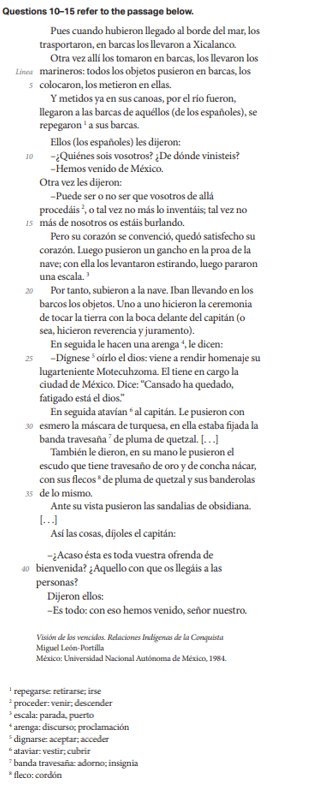
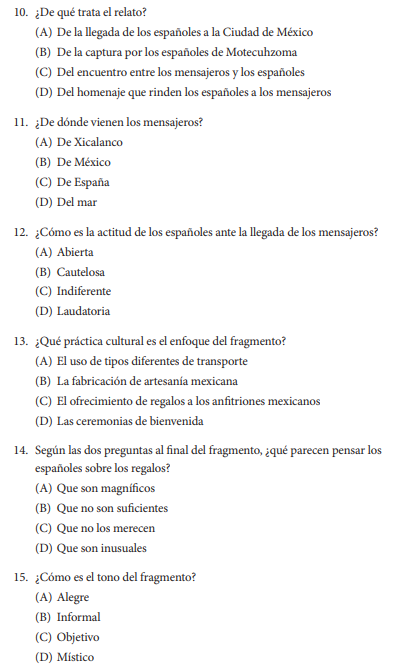
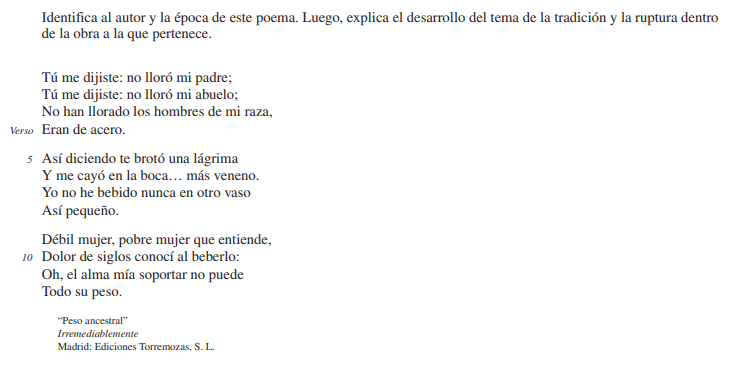

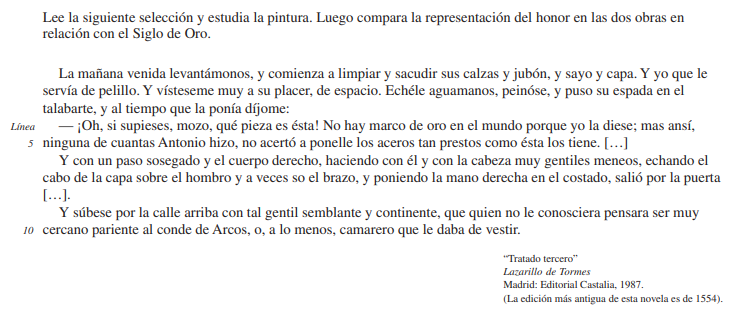
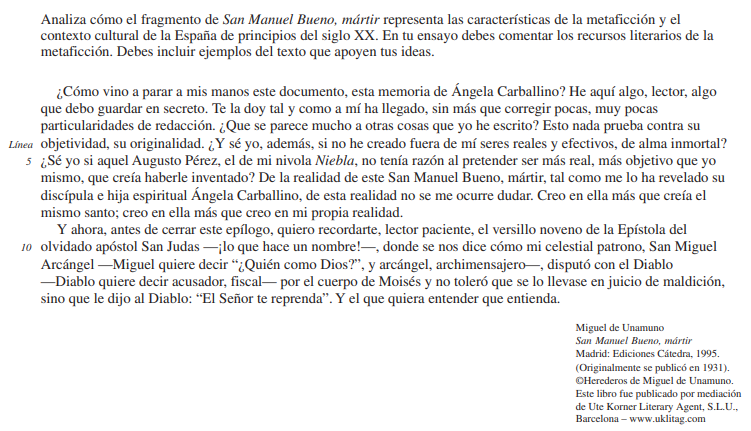
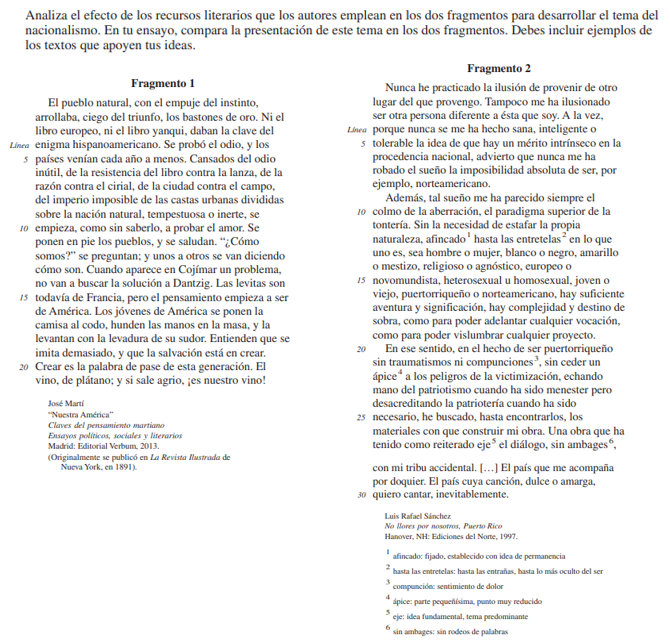
AP Spanish Literature and Culture Score Distribution, Average Score, and Passing Rate
Exam
5
4
3
2
1
AP Spanish Literature and Culture
9.5%
25.0%
37.7%
21.4%
6.3%
Best Ways to Study for the AP Spanish Literature and Culture Exam
Step 1: Assess Your Knowledge
Step 2: Study the Material
Step 3: Practice Multiple-Choice Questions
Step 4: Practice Free-Response Tasks
Step 5: Take Another Practice Test
Step 6: Exam Day Specifics







